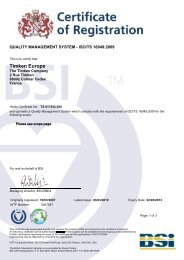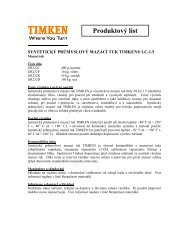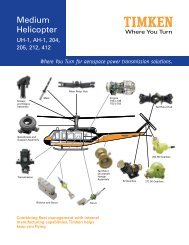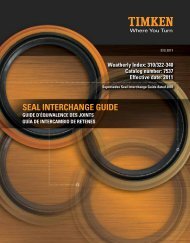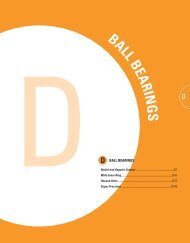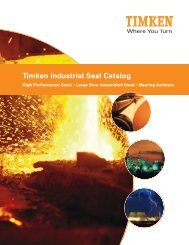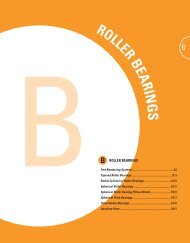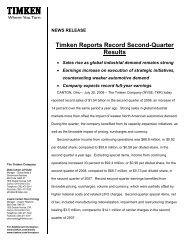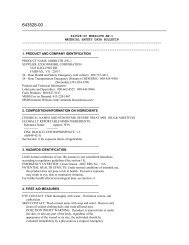Technical Paper - Timken
Technical Paper - Timken
Technical Paper - Timken
Create successful ePaper yourself
Turn your PDF publications into a flip-book with our unique Google optimized e-Paper software.
Introduction - The Design Challenge<br />
Of An Epicyclical Gearing System<br />
An epicyclical gearing system is particularly well suit-<br />
ed for achieving a high-reduction ratio in a relatively small,<br />
power dense package. A typical straddle mounted plan-<br />
etary idler is shown in Fig. 1.<br />
FIGURE 1 – CONVENTIONAL PLANETARY IDLER<br />
This blend of features has made it a popular choice<br />
for the designers and, consequently, it has been incorpo-<br />
rated into countless types of equipment, including auto-<br />
mobile transmissions, off-highway equipment final drives,<br />
wind turbine gearboxes and cement mill crusher drives,<br />
to name a few.<br />
As with any type of power transmission system, the<br />
engineer is faced with many analytical challenges during<br />
the design phase to ensure that a highly reliable power<br />
train is achieved. In the case of an epicyclical gearing sys-<br />
tem, this challenge is made particularly difficult due to the<br />
complex interaction of revolving and rotating components<br />
as they transmit power.<br />
In the traditional epicyclical gearing system, where<br />
the distance between planetary gear centerlines is spec-<br />
ified by the design to be within a fixed range, it is wide-<br />
ly recognized that the load sharing is not equal among<br />
the planetary gear meshes. Similarly, the stress distribu-<br />
tion at each mesh point contains variability. Load shar-<br />
ing and stress distribution at each mesh point are heavi-<br />
ly influenced by the global design configuration, backlash<br />
tolerance, component design tolerances, manufacturing<br />
accuracy, component deflection and thermal distortion.<br />
See Fig. 2 which shows in exaggerated form that contact<br />
is made at the mesh points of planet a-1 before any con-<br />
tact is made at the mesh points of the other planets. In a<br />
rigid system, this condition imposes unbalanced loading<br />
among the planetary idlers.<br />
FIGURE 2 – GEAR MESH CONTACT VARIABILITY<br />
The traditional approach to accounting for this vari-<br />
ability is to apply safety factors during the design phase.<br />
Factors accounting for load distribution among plan-<br />
ets, the torsional wind up of the planetary carrier assem-<br />
bly, the contact pressure exerted on the gear faces and<br />
many more are published by AGMA and other sources<br />
and are used frequently in today’s design process with<br />
good success. Additionally, very advanced computer<br />
programs linking finite element analysis with gear design<br />
algorithms and with the safety factors just mentioned are<br />
commercially available and are used by most gear de-<br />
sign centers in conjunction with their own proprietary de-<br />
sign practices.



